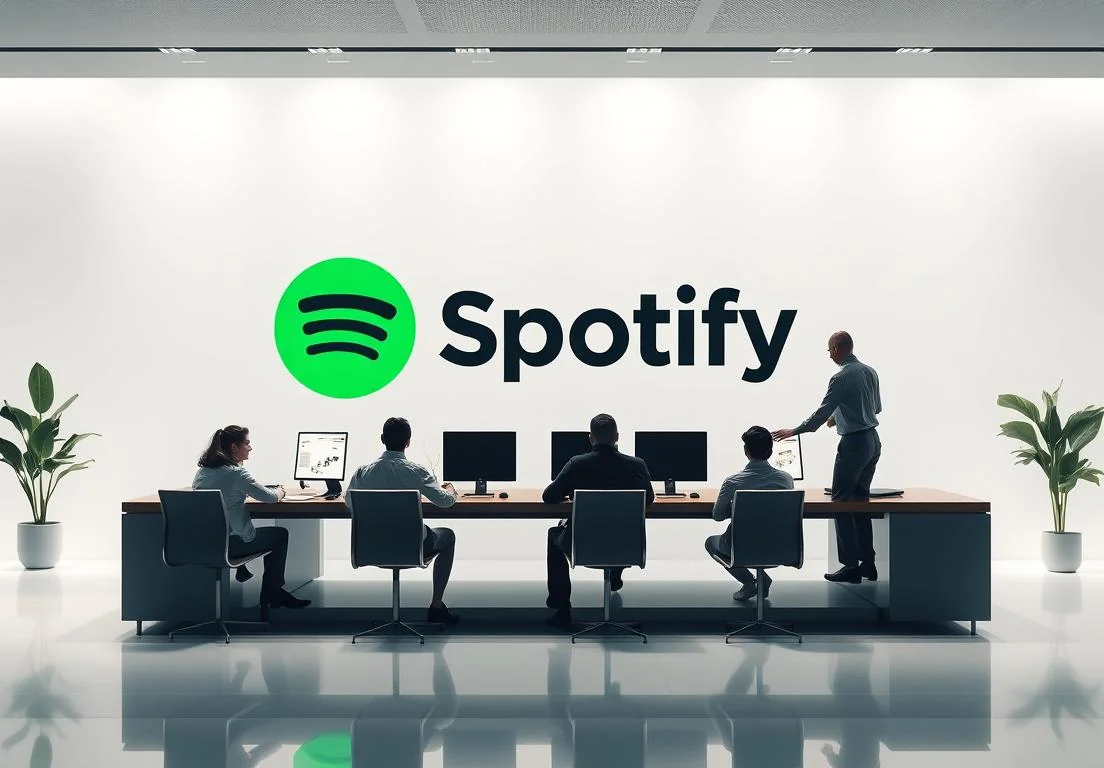Spotify is not just redefining music streaming; it’s also pushing the boundaries of technology. With an influx of innovative projects, there are numerous opportunities waiting to be explored.
Spotify’s tech innovation projects present a treasure trove for tech enthusiasts and creators alike. From AI-driven playlists to advanced audio analytics, the landscape is rich with possibilities. And it doesn’t stop here—there’s a whole world of insights and opportunities that could shape your next steps creatively and professionally. Let’s dive deeper into what’s on offer.
Key Takeaways:
- Spotify’s AI-driven recommendations and user data analytics open up avenues for personalized music experiences and strategic artist engagement.
- Interactive audio content, including live streaming and choose-your-own-adventure podcasts, enhance user involvement and redefine media consumption.
- Investing in blockchain technology for music rights management promises fairer compensation for artists and innovative content ownership opportunities.
1. AI Innovations in Music Recommendations
Spotify’s embrace of AI technology has transformed how listeners discover tunes they love. With sophisticated algorithms that analyze user preferences, the platform can curate playlists tailored to individual tastes. Imagine hearing a song for the first time and feeling like it was crafted just for you. That’s the magic of Spotify’s personalized music suggestions.
What’s particularly exciting is how these AI innovations are constantly evolving. They don’t just take into account what you’ve listened to before; they incorporate contextual data. This can mean the time of day, your location, or even the playlists you’ve interacted with regularly. The result? A listening experience that feels dynamic and engaging.
For anyone looking to tap into Spotify’s burgeoning tech projects, consider exploring how machine learning is applied to enhance user interactivity. Think about how you can leverage insights from your listening habits to create your unique playlists that resonate with your style.
2. Interactive Audio Experiences
Interactive content is reshaping Spotify, offering listeners a new way to engage with audiobooks and podcasts. Popular offerings now include choose-your-own-adventure styles in storytelling podcasts, where your choices can affect the narrative flow. This shift not only makes audio content more immersive but also invites users to partake actively rather than passively consuming media.
Podcasts are evolving too. The push for interactive features means listeners can ask questions, engage directly with content creators, or even contribute their narratives. Imagine finishing a gripping episode and immediately diving into a Q&A session with the host.
In terms of opportunities, think about how you might develop your interactive audio project. Consider the key elements that can enhance listener engagement, such as:
- Feedback Loops: Allow listeners to share their thoughts directly in the app.
- Personalized Interactions: Use user data to tailor experiences.
- Collaborative Features: Facilitate co-creation of content among listeners.
With these innovations, Spotify’s platform isn’t just a place to listen—it’s a space where you can perform, share, and connect with a community around audio storytelling.
3. Data-Driven Insights for Artists
Spotify’s suite of data-driven tools is a game-changer for artists trying to understand their audience better. Tools like Spotify for Artists allow musicians to analyze listener demographics, track growth trends, and gain insights into how their music is performing across different locations.
Moreover, with features like Audience Analysis, artists can see who’s listening to their tracks, including details like age, gender, and even location. This is invaluable for planning tours or crafting marketing strategies that resonate with specific groups.
For those looking to dive deeper, consider using Playlist Analytics. This feature helps artists understand how songs perform on various playlists, making it easier to align musical releases with listener habits. Plus, Spotify’s Canvas feature not only enhances the listening experience but also provides data on how visual elements affect engagement.
One unique angle to explore is the Spotify Ranbow Project, a program focused on fostering diversity and inclusion in music. By participating, artists can gain access to exclusive workshops and mentorship opportunities that help them leverage data insights to reach their audience effectively.
4. Collaborations with Tech Giants
Spotify’s collaborations with leading tech companies are reshaping the landscape of music technology. By teaming up with giants like Google, Spotify has integrated features that allow seamless streaming through Google Home devices. This means artists’ tracks can be easily accessible, creating a more interactive experience for listeners.
Another notable partnership is with Facebook, enabling Spotify to enhance social sharing capabilities. This integration allows artists to share their music directly on social media, boosting visibility and driving engagement.
These partnerships are not just about expanding reach; they also focus on innovation. For instance, initiatives like collaboration with various audio tech firms have led to improved sound quality and personalized listening experiences through algorithms that adapt to listener preferences.
For artists, keeping an eye on these collaborations can open doors. Engaging with platforms or features under development—like the personalized playlists and advanced algorithm recommendations—can help in getting their music to more ears.
Also, watch how these partnerships can provide access to new markets. For example, an alliance with regional streaming platforms can help artists break into diverse locales, increasing their fan base. Keeping tabs on these tech tie-ups means you can smartly leverage them, whether via promotional strategies or content creation that aligns seamlessly with these innovations.
5. Blockchain Technology in Music
Spotify’s diving into blockchain technology could change the game for music rights management. Essentially, blockchain offers a transparent ledger for tracking ownership, ensuring artists get their fair share without the usual headaches. The potential here isn’t just in making transactions easier; it’s about creating a system where artists can prove ownership and establish direct relationships with fans.
By experimenting with smart contracts, Spotify can automate payment distributions, cutting out middlemen and streamlining royalties. This tech innovation could lead to faster payments and less friction for artists who traditionally struggle with getting paid on time.
For those involved in content creation, it’s an exciting prospect. Engaging with blockchain could mean creating exclusive content linked to ownership tokens, allowing fans to buy into their favorite artists’ success. This isn’t just about the music; it’s an entire ecosystem built around authentic visibility and artists’ rights.
6. The Future of Live Streaming Events
Spotify’s initiatives in live streaming concerts and events are reshaping how fans experience live music. The company’s focus on streaming allows anyone, anywhere, to attend a concert from their living room, creating an incredible opportunity for artists to connect with global audiences.
With platforms already like Spotify Live, artists can host interactive performances that blend real-time engagement with live music. Fans can request songs or even ask questions, making those virtual concerts feel personal.
A unique angle to consider is the integration of augmented reality (AR). Imagine tuning into a concert where you could see virtual stages in your living room, or where AR enhances the performance with visuals that respond to the music. This could boost ticket sales and engage fans in a way that traditional concerts never could.
To get involved or leverage this opportunity as an artist, focus on crafting unique live experiences. Think exclusive access to behind-the-scenes content or interactive Q&A sessions. Additionally, the use of innovative tech can attract sponsorships and brand partnerships eager to reach Spotify’s engaged audience. This can help artists not only create memorable shows but also build a sustainable revenue model through innovative offerings.
7. Sustainability in Tech Projects
Spotify’s commitment to sustainability is more than just a tag on their corporate social responsibility page. They’re integrating eco-friendly practices into their tech innovations to minimize their carbon footprint. One exciting avenue is their push towards renewable energy. Spotify has pledged to run on 100% renewable energy and is actively seeking tech solutions that optimize energy usage across data centers.
Moreover, Spotify’s tech teams are exploring algorithms that help assess and reduce energy consumption during peak usage times. Think about features that allow streaming quality to adjust dynamically based on available bandwidth — not just enhancing user experience but also reducing energy waste.
An area ripe for innovation is the development of features that engage users in sustainability efforts, like playlists highlighting eco-conscious artists or even carbon footprint trackers for their listening habits. This can foster a deeper connection between Spotify’s services and the environmental impact of consumers’ music choices. So, if you’re looking at opportunities within Spotify, focusing on sustainable tech solutions could be a promising route.
8. Enhancements in User Interface and Experience
Spotify’s latest upgrades in their user interface show they are serious about enhancing engagement. The redesign aims to create a more intuitive experience. Features like dynamic playlists that change based on listening habits keep content fresh and personalized, captivating listeners.
One great enhancement is the “Discover” tab, which tailors recommendations based on what you’re currently enjoying. This not only makes it easier for users to find new music but also encourages them to explore unfamiliar genres. Additionally, the incorporation of visual album art and artist backgrounds offers a rich multimedia experience, drawing users deeper into the platform.
Looking ahead, there’s a unique opportunity to focus on enhancing community engagement features. Imagine options to create shared playlists with friends or collaborative listening sessions in real time. This could strengthen user connections while keeping Spotify the go-to choice for music lovers. All these user interface changes are solid moves to keep Spotify relevant and enjoyable for every type of listener.
9. Trivia: Spotify’s Growth and Milestones
Spotify has truly transformed the music streaming landscape since its inception. Did you know that it took just over 10 years for Spotify to hit 100 million premium subscribers in 2021? That’s a testament to how well they’ve tapped into listeners’ desires for on-demand music, personalized playlists, and seamless user experiences.
Throughout its journey, Spotify has reached several technological milestones that highlight its innovation and commitment to improving how we consume music. For starters, the introduction of Discover Weekly in 2015 changed the game for personalized listening by providing tailored playlists based on users’ listening habits. This feature alone has won numerous accolades and shows how Spotify uses data-driven algorithms to enhance user engagement.
Another pivotal moment was the launch of Spotify Wrapped in 2016, an end-of-year recap that not only celebrates listeners’ habits but also sparks social sharing. It’s not just a marketing gimmick—it’s a savvy way to keep users invested and engaged with the platform year after year.
In terms of tech innovation, Spotify has also been exploring podcasting and audio content. Acquiring big names like Gimlet Media and Anchor has solidified its footprint in the podcasting realm, diversifying content offerings and appealing to a broader audience. This avenue allows Spotify to leverage existing technologies to create a richer, more engaging listening experience.
Spotify isn’t stopping there. They continue to invest in AI and machine learning to further refine their recommendation systems and enhance user experiences. With machine learning, they can analyze vast amounts of data, predicting what users will love next, which keeps the content feeling fresh and personalized.
Quick Q&A:
What tech skills are most in-demand at Spotify?
Skills in machine learning, data analysis, and engineering are highly sought after, as they are pivotal for developing new features and enhancing the user experience.
Is Spotify involved in any sustainability projects?
Yes, Spotify is committed to sustainability, aiming to power operations with 100% renewable energy and reduce its carbon footprint across its global offices.
How can I get involved with Spotify’s tech initiatives?
They often have internship programs and job openings available for tech roles. Keep an eye on their careers page for the latest opportunities.
Are there opportunities for developers at Spotify?
Absolutely! Spotify offers developer tools and APIs that allow third-party developers to build innovative applications and enhance the Spotify ecosystem.
What innovations can we expect from Spotify in the near future?
Given their focus on AI, personalized content, and expanded podcast offerings, expect even more integration of interactive and immersive audio experiences soon.




